Physical Address
304 North Cardinal St.
Dorchester Center, MA 02124
The orbit is an area that neurosurgeons may approach for orbital tumors with an intracranial component or as a corridor to access the anterior cranial fossa. Approaches to the orbit can be transorbital (within or through the orbit), endonasal, transcranial or combined approaches. A multidisciplinary team is frequently required, working together with an otorhinolaryngologist and/or ophthalmologist.
In this chapter approaches to the orbit and periorbital regions through the eye and nose to remove tumors, to repair CSF leaks, for abscess drainage, or decompression of the orbit or optic nerve are described.
Anatomical pearl: The shape of the orbit is compared to a four-sided pyramid in which the apex is located posteriorly and the base anteriorly.
Special CT and MRI series centered at the orbit and with thin cuts are useful to study the orbit and to better define any pathology. MRI with fat suppression allows better visualization of the orbital structures decreasing the hyperintensity of the orbital fat.
Visual fields and fundoscopy examination are important preoperative studies that allow choosing a more appropriate surgical approach considering the optic nerve function.
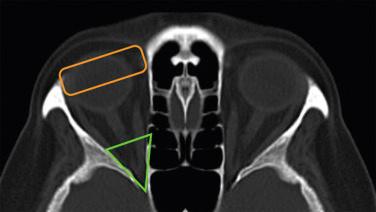
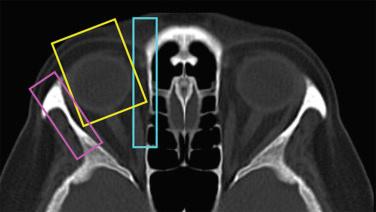
Orbital lesions.
Orbital lesions with intracranial or intranasal invasion.
Hemangioma, hamartoma, neurofibroma, osteoma, chondroma, optic nerve glioma, meningioma, mucocele and lymphoma.
Wide orbital and optic canal decompression are recommended through a transorbital approach.
For Graves disease (exophthalmos) optic nerve decompression is recommended by an endoscopic approach.
Management of apex lesions is not recommended by transorbital approaches, because the cranial nerves can be damaged while reaching the apex pathology, causing an iatrogenic orbital apex syndrome or sphenoid fissure syndrome.
The lateral orbitotomy is avoided for pathologies that extend into the optic canal, because it has the potential complication of lateral rectus muscle paresis, upper eyelid ptosis and orbital hemorrhage.
Endonasal transorbital approaches are avoided for pathologies that are laterally beyond the mid-orbital or optic nerve axes.
For monocular patients, extreme care is recommended on the selection of the approach. If the preserved side is being approached, the possibility of loss of remaining vision needs to be discussed with the patient.
The best surgical approach to the orbit is guided by the location of the lesion, as set out in Table 36.1 .
| Surgical approach | Indications |
|---|---|
| Transorbital Approaches (see also Figures 36.2 and 36.4 ) | |
| Anterior | |
| Eyelid crease | Superior-base lesions (better cosmetic results compared with eyebrow incision) |
| Eyebrow | Superior-base lesions |
| Conjunctival fornix | Inferior orbital lesions |
| Medial | |
| Transconjunctival | Lesion on the floor or roof of the orbital cavity |
| Transcaruncular | Medial orbital wall, apex and extraconal tumors |
| Lateral | |
| Lateral orbitotomy | Retrobulbar lesions Well-circumscribed periorbital and intraconal lesions (dorsally, basally and laterally optic nerve) Lacrimal gland lesions Orbital apex and medial optic nerve lesions should NOT be operated by this approach |
| Combined approaches | Apex and medial optic nerve |
| Extraorbital transcranial approaches | |
| Orbitozygomatic approach (see Chapter 18 ) | Supraorbital roof and lateral orbital wall + lateral anterior and/or medial fossa |
| Bifrontal approach (see Chapter 20 ) | Bilateral or midline lesions (anterior cranial fossa) Supraorbital roof and/or medial/lateral orbital wall |
| Supraorbital approach (with standard or with eyelid/eyebrow incisions) (see Chapter 19 ) | Unilateral lesions (anterior cranial fossa) Anterior cranial fossa and orbital roof |
| Pterional approach + osteotomy (modified orbitozygomatic) (see Chapter 18 ) | Supraorbital roof and/or lateral orbital wall + lateral anterior fossa and/or lateral media fossa |
| Extraorbital endoscopic approaches | |
| Endoscopic endonasal approach | |
| Endoscopic endonasal transsellar | Chiasm, optic nerve decompression |
| Endoscopic endonasal transorbital | Lesions located on medial orbital wall |
| Transantral endoscopic approach (transmaxillary sinus) | Lesions located on inferior orbit |
For this section we have selected the most useful transorbital approaches for the neurosurgeon. In the minimally invasive era, the orbit has been used in very selected patients as a natural corridor to access deep areas of the anterior cranial fossa avoiding the use of large incisions and craniotomies. Knowledge of those approaches is important because their indications and uses are expanding (see Figure 36.3 ):
Supraorbital approach (see Chapter 19 ): Eyelid and eyebrow incisions that were used by ophthalmologist or cosmetic surgeons have been implemented to give access to the anterior cranial fossa, orbital roof and frontal sinus with improved cosmetic results (see Figure 36. 4 ).
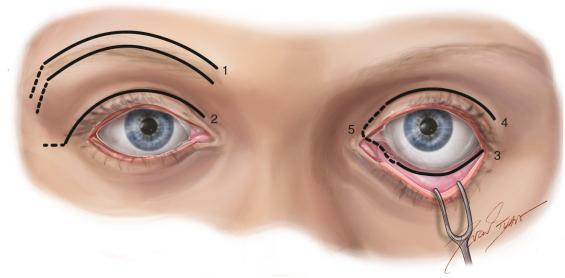
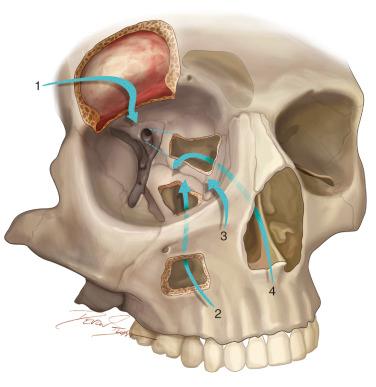
Transcaruncular approach: This approach can provide access to the anterior cranial fossa, nasal fossa and medial orbital wall.
Endoscopic endonasal approach (transellar and transorbital variants): Sagittal and coronal expansions of the approach to the sella can provide access to the optic nerve, chiasm and medial orbital wall for pathology extending to those areas or optic nerve decompression.
Transantral endoscopic approach : Although this approach is more used by ENT surgeons, it is important to understand its use alone or in combined approaches to access the maxillary sinus and orbital floor for pathology extending to those areas.
CSF leaks
Esthesioneuroblastoma
Encephaloceles
Extraconal tumors, as meningiomas, hemangiomas
Ethmoidal mucocele with or without orbit extension.
The head is positioned slightly extended (10°) and rotated contralateral to the lesion such that the eye is parallel to the floor and the surgeon is working perpendicular to the floor.
A corneal shield is recommended to avoid dehydration and abrasion of the cornea and conjunctiva.
Conjunctival topical anesthetic is applied with lidocaine eye drops and the upper eyelid and medial canthus are infiltrated with lidocaine.
The precaruncular incision is made between the semilunar fold and caruncle and can be extended to the superior and inferior fornices avoiding the lacrimal system ( Figure 36.5 ).
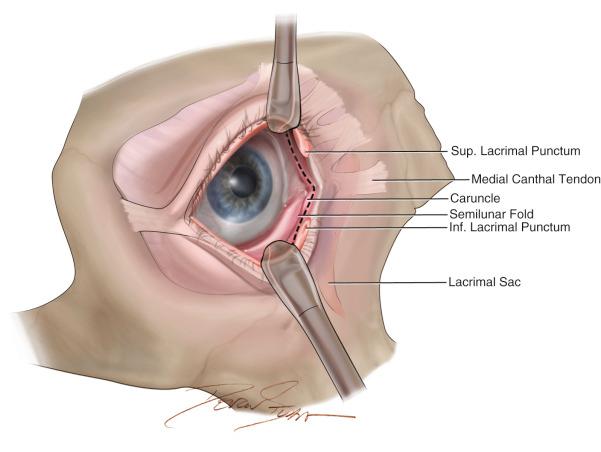
Become a Clinical Tree membership for Full access and enjoy Unlimited articles
If you are a member. Log in here